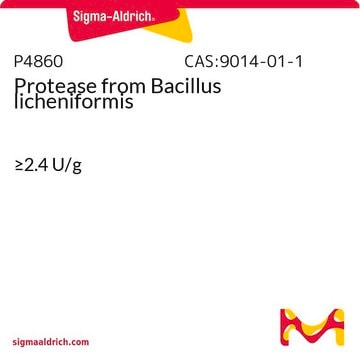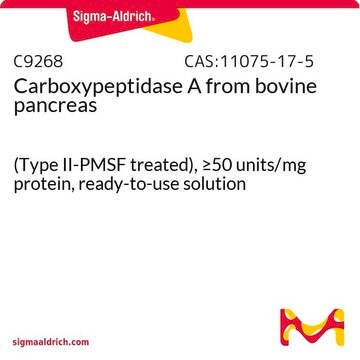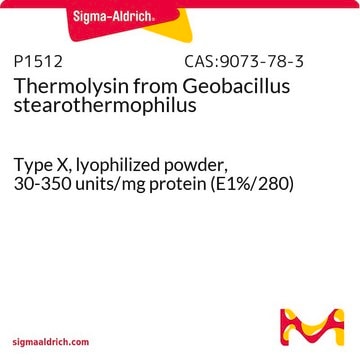T7705
Thimet Oligopeptidase from Bacillus licheniformis
Sign Into View Organizational & Contract Pricing
All Photos(1)
About This Item
Recommended Products
Related Categories
General description
Thimet oligopeptidase is considered essential in the degradation of collagen in collaboration with collagenolytic enzymes. Thimet oligopeptidase (TOP) is a neuropeptidase involved in the hydrolysis of gonadotropin-releasing hormone, a key component of the hypothalamic-pituitary-gonadal axis.
Application
Thimet oligopeptidase can be used for the degradation of collagen in combination with collagenases. It can also be used for the hydrolysis of neuropeptides such as bradykin, neurotensin, and amyliod-β-peptide. Thimet oligopeptidase has been used in a study to investigate the effect of acute cocaine administration in male rats on TOP specific activity and mRNA levels in prosencephalic brain areas related with the reward circuitry: ventral striatum, hippocampus, and frontal cortex.
Preparation Note
This enzyme has been affinity chromatographically purified using a niquel affinity column. It contains a 6-Histidine tag in its C-terminus.
A working solution of this enzyme can be prepared in 20 mM phosphate buffered saline solution, pH 7.0, or sterile and deionized water, pH 7.0.
A working solution of this enzyme can be prepared in 20 mM phosphate buffered saline solution, pH 7.0, or sterile and deionized water, pH 7.0.
Signal Word
Warning
Hazard Statements
Precautionary Statements
Hazard Classifications
Acute Tox. 4 Inhalation - Skin Irrit. 2
Storage Class Code
11 - Combustible Solids
WGK
WGK 3
Flash Point(F)
Not applicable
Flash Point(C)
Not applicable
Certificates of Analysis (COA)
Search for Certificates of Analysis (COA) by entering the products Lot/Batch Number. Lot and Batch Numbers can be found on a product’s label following the words ‘Lot’ or ‘Batch’.
Already Own This Product?
Find documentation for the products that you have recently purchased in the Document Library.
T John Wu et al.
Journal of neuroendocrinology, 21(4), 293-298 (2009-02-13)
Gonadotrophin-releasing hormone (GnRH) was first isolated in the mammal and shown to be the primary regulator of the reproductive system through its initiation of pituitary gonadotrophin release. Subsequent to its discovery, this form of GnRH has been shown to be
Akio Kawasaki et al.
The Journal of biological chemistry, 285(45), 34972-34980 (2010-09-08)
Pz-peptidase A, from the thermophilic bacterium Geobacillus collagenovorans MO-1, hydrolyzes a synthetic peptide substrate, 4-phenylazobenzyloxycarbonyl-Pro-Leu-Gly-Pro-D-Arg (Pz-PLGPR), which contains a collagen-specific tripeptide sequence, -Gly-Pro-X-, but does not act on collagen proteins themselves. The mammalian enzyme, thimet oligopeptidase (TOP), which has comparable
Lilian C Russo et al.
Proteomics, 12(17), 2641-2655 (2012-06-29)
Protein interactions are crucial for most cellular process. Thus, rationally designed peptides that act as competitive assembly inhibitors of protein interactions by mimicking specific, determined structural elements have been extensively used in clinical and basic research. Recently, mammalian cells have
Kirsty Cleverly et al.
Reproduction (Cambridge, England), 139(2), 319-330 (2009-09-17)
LHRH (GNRH) was first isolated in the mammalian hypothalamus and shown to be the primary regulator of the reproductive neuroendocrine axis comprising of the hypothalamus, pituitary and gonads. LHRH acts centrally through its initiation of pituitary gonadotrophin release. Since its
Fernanda M Cunha et al.
The Journal of biological chemistry, 283(36), 24448-24459 (2008-07-12)
Protein degradation by the ubiquitin proteasome system releases large amounts of oligopeptides within cells. To investigate possible functions for these intracellularly generated oligopeptides, we fused them to a cationic transactivator peptide sequence using reversible disulfide bonds, introduced them into cells
Our team of scientists has experience in all areas of research including Life Science, Material Science, Chemical Synthesis, Chromatography, Analytical and many others.
Contact Technical Service









